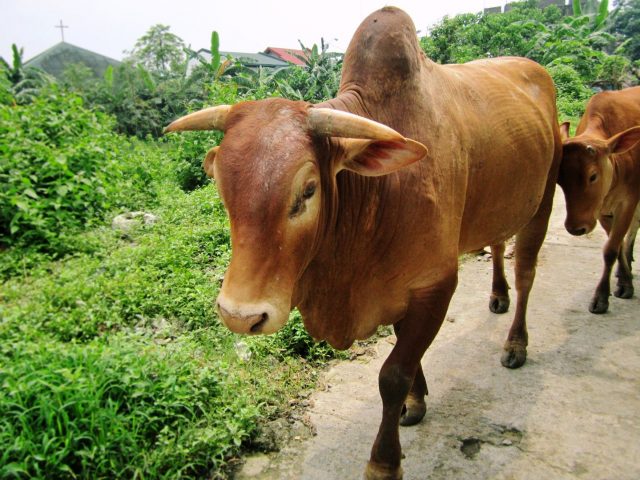Type the name of the breed you're looking for below
[wpdreams_ajaxsearchlite] Don't see the breed your're looking for? Click here and let us know!
Ongole cattle
| Place of Origin | India |
| Origin | Ongole cattle are famous for their bulls. Traditionally, the Ongole have been raised by local farmers, fed by both the Gundlakamma, one of the rivers that originates from the Nallamala Hills, and in the plains, the Paleru river, a tributary of the Krishna River. The Ongole occupy an area no larger than about 100 square miles between the Gundlakamma and Musi rivers. Ongole bulls have gone as far as America, the Netherlands, Malaysia, Brazil, Argentina, Colombia, Mexico, Paraguay, Indonesia, West Indies, Australia, Fiji, Mauritius, Indo-China and Philippines. The Brahmana bull in America is an off-breed of the Ongole. Ongole Island is an island located in Malaysia where many Ongoles can be found. The population of Ongole off-breed in Brazil is said to be around several millions. The famous Santa Gertrudis breed developed in Texas, USA have Ongole blood. |
| Purpose | These cattle are commonly used in bull fights in Mexico and some parts of East Africa due to their strength and aggressiveness. They are also used for dairy and draught (work). |
| Appearance | The Ongoles are large-sized animals with loosely knit frames, large dewlaps which are fleshy and hang in folds extending to the navel flap, and slightly pendulous sheaths. They have long bodies and short necks; limbs are long and muscular. The forehead is broad between the eyes and slightly prominent. Eyes are elliptical in shape with black eyelashes and a ring of black skin about 1/4 to 1/2 inch wide around the eyes. Ears are moderately long, measuring on an average for 9 to 12 inches, and slightly drooping. The hump in the males is well-developed and erect and filled up on both sides and not concave. The skin is of medium thickness, mellow and elastic and often shows black mottled markings. The popular color is white. The male has dark gray markings on the head, neck and hump and sometimes black points on the knees and on the pasterns of both the fore and hind legs. A red or red and white animal of typical conformation is occasionally seen. They have a white switch of the tail, white eyelashes, a flesh colored muzzle, light colored hooves, dark gray marking on the hindquarters and dark mottle appearance on the body. Ongole cattle are efficiently used in their native home for both work and milk production. They are usually docile and the bulls are very powerful, suitable for heavy plowing or car work but are not considered to be suitable for fast work or trotting purposes. The cows are fair milkers. All animals currently used for food and agriculture and the result of Domestication from wild progenitor species like their wild relatives. These Domestic species are continuously evolving albeit at an accelerated rate due to human activity. In general the history of cattle followed the history of man, where even either primitive or modern. Man has migrated he has tended to bring with him his own breeds of cattle. During vedic period many of the useful animals have been brought under service of man, particularly Milk became useful since Rigvedic period. The selected those animals species that are having vigor, inborn nearness, social ability and docility. The evolutionary process has been accelerated in the domestic species particularly cattle, as a consequence of 10,000 years of selection by human, during this period with in the species genetic variation which is essential for the survival of all species, has been partially redistributed in the formation of the large number of unique cattle breeds now exists. These breeds have adopted too many environments as the breeds spread and have been used to produce different types and combinations. A major group of mammals to be domesticated after caprinae were the large ruminants (Bovinae), which included the humped (Bos indicus) and hump less (Bos Taurus) cattle, yak, mithun, banteng and buffalo. This range of species in the family Bovinae make a very large number of important contributions to food and agriculture, providing just under 30% world meat and 87% world milk. This Bovinae provided the planet with a means of digesting via fermentation. Same types of zebu animals are present from the time of Indus Valley civilization dating back to 3000 BC Indian subcontinent is a treasure house of Bos-Indicus Cattle. Farmers in the breed tract has selected and preserved each successive variation, with the distinct intention of improving and altering a breed, in accordance with a preconceived idea, and by thus adding up variations, often so slight as to be imperceptible to the uneducated. He has effected wonderful changes and improvements in the direction he desired as we see here under in Ongole Breed from 1880. There is a tendency in the breed to grow leggy with sparse light carriage, but their form, temper and endurance earned nearness to the breeders. |
| Horns | Horns are short and stumpy, growing outwards and backwards, thick at the base and firm without cracks. In some animals the horns are loose; this is probably due to the horn core not growing well. |
| Cows Average Weight | 430 kg (948 lbs.) |
| Bulls Average Weight | 500 - 600 kg (1,102 - 1,323 lbs.) |
| Other Considerations | Ongole cattle are known for their toughness, rapid growth rate, and natural tolerance to tropical heat and disease resistance. It was the first Indian breed of cattle to gain worldwide recognition. The bull, Bos Indicus, is in great demand as it is said to possess resistance to both foot and mouth disease and mad cow disease. |



